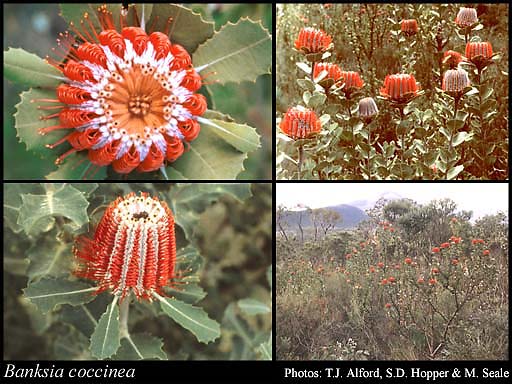- Reference
- Trans.Linn.Soc.London 10:207 (1810)
- Conservation Code
- Not threatened
- Naturalised Status
- Native to Western Australia
- Name Status
- Current
Non-lignotuberous, small tree or shrub, 1-8 m high. Fl. red & othergrey/orange, May to Dec or Jan. Grey or white sand. Coastal sand dunes, swamp margins, sandplains.

Scientific Description
Shrubs, 1.5-4 m high; branchlets hairy. Leaves sessile, alternate, 35-80 mm long, 30-75 mm wide, hairy; lamina flat, once divided, pinnately divided, shallowly divided, teeth distinctly pointing towards the apex, the margins flat. Inflorescences hirsute (with long, rough and coarse hairs), red, brown or grey; innermost bracts 10-15 mm long, hairy. Perianth 28-32 mm long, hairy, all over, limb apex villous (with soft, shaggy, weak and straight hairs), without awns; pistil 40-50 mm long, straight, style glabrous. Follicles hairy, tomentose (with matted or tangled, soft, woolly hairs), elliptic, 6-8 mm long. Flowers in January, May, June, July, August, September, October, November or December. Occurs in the South-west (SW) Botanical Province(s), in the Avon Wheatbelt (AW), Jarrah Forest (JF), Warren (WAR) or Esperance Plains (ESP) IBRA subregion(s).
Distribution
- IBRA Regions
- Avon Wheatbelt, Esperance Plains, Jarrah Forest, Warren.
- IBRA Subregions
- Fitzgerald, Katanning, Recherche, Southern Jarrah Forest, Warren.
- IMCRA Regions
- WA South Coast.
- Local Government Areas (LGAs)
- Albany, Cranbrook, Esperance, Gnowangerup, Jerramungup, Plantagenet, Ravensthorpe.